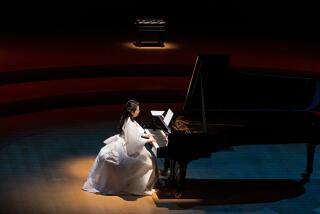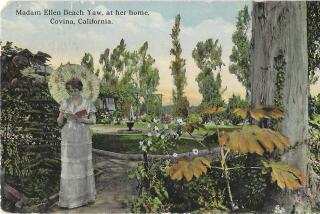MUSIC REVIEW
There isn’t much sex in John Adams’ operas or his work in general, which might explain why “Eros Piano” is so neglected. But there is plenty of musical sensuality all through his music, so even that explanation doesn’t quite account for why this lush, torchy 1989 valentine for piano and orchestra is seldom heard and has had but a single recording.
Still, at least a few have fallen for “Eros Piano.” Five years ago, Peter Martins choreographed the score for New York City Ballet. And for her annual contribution to the Piano Spheres series, Vicki Ray took matters into her own hands Tuesday night at the Colburn School’s Zipper Concert Hall. She premiered a solo version of “Eros Piano” that she made with the composer’s blessing.
The 15-minute piece was born, Adams said at the time, from an obsession with Toru Takemitsu’s “riverrun,” an equally short and dreamy work for piano and orchestra that was given its premiere by the Los Angeles Philharmonic in 1984.
Adams said that he so loved “riverrun,” which he had on his car stereo for weeks and couldn’t stop listening to, that he eventually had to write his own version to get the piece out of his system. His starting point was the interest he and the Japanese composer shared in the introspective style of jazz pianist Bill Evans.
And without the drowsy strings in the background, “Eros Piano” really does begin to sound more like Evans than Adams. But Ray’s languid, sumptuous performance made something else apparent.
“Eros Piano” can now be heard as a sketch for an incandescent, complex aria sung by Kitty Oppenheimer in Adams’ recent opera, “Doctor Atomic.” In this scene, Kitty tries to get in husband Robert’s light as he reads, as a way of getting in his psyche. The aria is among the most beautiful things Adams has written. So, for that matter, is “Eros Piano.”
Ultimately, I missed the strings. But Ray’s radiant playing served to reveal the significance of Adams’ feminine side, which he normally likes to present in a broader context.
Speaking of context, Ray’s entire program was one of concertos and cadenzas presented out of context. She began with Stravinsky’s Concerto for Two Pianos, a concerto that Stravinsky wrote without an orchestra. She played two piano cadenzas extracted from larger works: Rand Steiger’s “awhirl,” which the composer arranged as a short solo from his ensemble piece “Dreamscape,” and a piano solo from Frederic Rzewski’s “Pocket Symphony.”
She ended with “my lips from speaking,” a wild fantasia on the opening piano chords of Aretha Franklin’s “Think,” which Julia Wolfe wrote for six pianos but then refashioned as a solo piece with electronics, making it an offbeat (in many more ways than one) concerto.
All of this, other than “Eros Piano,” is dazzling, dizzying music. For Stravinsky’s concerto, Ray was joined by Bay Area pianist Julie Steinberg in a performance with rhythmic bite but with a fuller, warmer, less percussively brittle tone than is the norm for Stravinsky.
Like Wolfe, Steiger adds an electronic component to the piano, and he operated the soundboard at the back of the hall for “awhirl.” In so doing, he did indeed set the piano awhirl from loudspeakers surrounding the audience. He also added body to the sound. Yet even with all that, the real whirl came from Ray’s fingers, which were on continuous virtuosic dancing display here as well as in the flamboyant Rzewski cadenza.
I haven’t heard the six-piano original of Wolfe’s “my lips from speaking,” but this 15 minutes of grooving and bashing and banging on those familiar Franklin chords, along with much more keyboard thunder emanating from the speakers, created an irresistible air of funky celebration.
Ray’s encore was “My Funny Valentine,” and it was funny -- the melody played on a melodica, or blow organ, with her right hand and the accompaniment on an amplified toy piano with her left. It became the trickster yang to the “Eros Piano” yin.
--
More to Read
The biggest entertainment stories
Get our big stories about Hollywood, film, television, music, arts, culture and more right in your inbox as soon as they publish.
You may occasionally receive promotional content from the Los Angeles Times.











